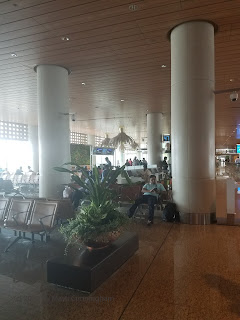The purpose of my trip in India was to expand my global perspective
in order to expand the perspective of my students. It did expand, but not in
the way that I expected. I did not realize that racism against Black people was
a global problem. I expected for other brown nations, like India, to be in
solidarity with other people of color. This is largely not the case. I found
out towards the end of the trip that all Black people who visit and live in
India experience serious racism. A US embassy official told me. Black women are
assumed to be prostitutes. They are sometimes attacked and raped in the streets
– right in Gujarat state, where I was alone for a week. (It seems I was protected when I got sick. My
nausea made me stick close to the hotel and I never went out alone.) Black men
are assumed to be drug dealers. The Black wives of US embassy personnel experience extreme racial discrimination, despite having diplomatic credentials. When I
first returned home, I felt wounded and angry. Now, I am glad to have had the
experience. I needed to know what challenges world – wide that people of African
descent face. I also really appreciate my own Civil Rights Movement, the Black
Power Movement and Black is Beautiful Movement. African – American literally
threw away a colonized mind for one that is liberated. I think of the different
people that I met in India with affection. The musicians, dancers and educators are
right now living full and productive lives, a full ten and a half hours ahead of
mine. It was interesting to meet other productive adults who have a very
different life from mine. People who are kind and complicated and caring. I
think of them with deep affection.
Ironically, I did find a remnant of the Indian Independence
Movement while I was in New Delhi.
Another teacher on the trip, Judy, the former curator and
history teacher from Boston, found the Gandhi Peace Foundation and got us an
appointment with the director. This is the center of the Indian Freedom
Movement. Activists from all over the country go there to study, network and
organize. There is an extensive library of all works published by and about
Gandhi. The center was founded by his followers after his assassination in
1948. And guess who studied there. Our Dr. Martin Luther King. He visited in
February and March of 1959. A recording of a broadcast Dr. King made to the people of India on that trip in 1959 was discovered in
2009. In it he says:
Since being in India, I am more convinced than ever before that the method of nonviolent resistance is the most potent weapon available to oppressed people in their struggle for justice and human dignity. In a world since Mahatma Gandhi embodied in his life certain universal principles that are inherent in the moral structure of the universe, and these principles are as inescapable as the law of gravitation.
Judging from his words, we African – Americans owe India a
great debt. Their non-violent resistance movement catalyzed freedom struggles
on the African Continent and here at home in the US. The African – American movement
triggered those in progress now with Blacks in Latin America.
Once I returned home, I started to research Blacks in India.
There are communities of Blacks in Karnataka and Gujarat called the Siddis. It
was even a wealthy Siddi man who built a mosque that we visited in Ahmedabad that
is famous of its intricate lattice work. (Click here for more info) Learning
about the Siddis and hearing their rich traditional music brought me healing.
In one of her emails when I first returned, Maya Menon said that she hoped that I could accept India “warts and all.” My
initial reaction was “Noo..I will never accept racial oppression!” However,
considering the connected histories of African – America and India, Dr. King’s
time there, the affection that I feel for my hosts, I am happy to say that I do
accept India, “warts and all.” (smile)










































